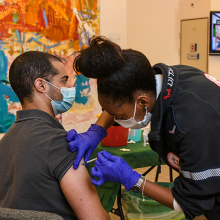New hope for Gaucher patients
Discovery challenges current theories
Briefs

Prof. Tony Futerman’s lab in the Department of Biological Chemistry has recently discovered a new cellular pathway implicated in Gaucher disease which may offer a new therapeutic target for the disease and related disorders.
Gaucher disease is a genetic disorder most prevalent among the Ashkenazi Jewish population. It is caused by a defect in a particular enzyme needed to break down a fatty substance, or lipid, called glucocerebroside. This results in the accumulation of the lipid in various cells and organs, stymieing their function. The most common form, Type 1, is characterized by swelling, enlargement, and dysfunction of the spleen and liver, along with lung and bone problems.
People with Types 2 and 3 Gaucher disease suffer from these symptoms and also have neurological symptoms; Type 2 – the most severe form – causes extensive brain damage and death before two years of age. Type 3 is a more progressive form of the disease that affects the brain, with patients often living into their early teens and adulthood.
An effective enzyme replacement therapy for Gaucher patients exists: Treatment involves injections of an intact version of the enzyme responsible for the normal breakdown of the lipid in healthy people. The cost of the lifelong treatment is approximately $200,000 per patient per year. Moreover, the enzyme is unable to get into the brain since it cannot cross the blood-brain barrier, rendering it ineffective in treating the neurological symptoms of Types 2 and 3 Gaucher disease. Hence, more affordable and alternative treatments are urgently needed.
But what exactly causes such a massive loss of nerve cells in Types 2 and 3 Gaucher disease? It has recently come to light that a certain biochemical pathway, of which a protein called RIP3 is a key player, is involved in triggering the cell death and inflammatory processes that can have severe consequences in a number of diseases. Prof. Futerman’s team wondered whether this could also be one of the missing links in the chain of molecular events leading to brain inflammation and nerve cell death in Gaucher disease.
To find out, they induced Gaucher disease in mice possessing the RIP3 protein, as well as in mice lacking RIP3. In mice lacking the protein, they demonstrated not only a significant improvement in motor coordination and brain pathology but also improved liver and spleen function. Their lifespan was also remarkably increased from approximately 35 days to more than 170 days.
These exciting results, published in Nature Medicine, suggest a plausible new target for therapeutic intervention for all types of Gaucher disease - one that may greatly improve patients’ quality of life. With RIP3 proving to be a “hot” cellular pathway in various pathologies, these results may also have implications in other neurodegenerative diseases such as Krabbe disease.
Prof. Futerman is supported by the Nella and Leon Benoziyo Center for Neurological Diseases which he heads, the M.D. Moross Institute for Cancer Research, the Carolito Stiftung, and the Rosetrees Trust. He is the incumbent of the Joseph Meyerhoff Professorial Chair of Biochemistry.








